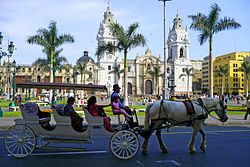Historic Centre of Lima
| Historic Centre of Lima | |
|---|---|
| Name as inscribed on the World Heritage List | |
 |
|
| Location | Peru |
| Type | Cultural |
| Criteria | iv |
| Reference | 500 |
| UNESCO region | Latin America and the Caribbean |
| Inscription history | |
| Inscription | 1988 (12th Session) |
| Extensions | 1991 |
Located principally in the city centre or Cercado de Lima and Rímac areas, the Historic Centre of Lima is among the most important tourist destinations in Peru.
The city of Lima, the capital of Peru, was founded by Francisco Pizarro on 18 January 1535 and given the name City of the Kings. Nevertheless, with time its original name persisted, which may come from one of two sources: Either the Aymara language lima-limaq (meaning "yellow flower"), or the Spanish pronunciation of the Quechuan word rimaq (meaning "talker", and actually written and pronounced limaq in the nearby Quechua I languages). It is worth noting that the same Quechuan word is also the source of the name given to the river that feeds the city, the Rimac river (pronounced as in the politically dominant Quechua II languages, with an "r" instead of an "l"). Early maps of Peru show the two names displayed jointly.
In 1988, UNESCO declared the historic center of Lima a World Heritage Site for its originality and high concentration of historic monuments constructed in the time of Spanish presence.
Of the structures in the historical center of Lima, situated are more than 1,600 balconies that were built in the viceroyalty era as well as in the republic. In order to retain its conservation, the Municipality of Lima has invited individuals and companies to adopt a balcony in order to maintain them as if they were new. The abundance of these balconies adds to the particular harmony and originality to this part of the city.
At the time of the Viceroyalty of Peru, a work of art was created, a magnificence, a grandeur and a legendary royal life.
The authority of the viceroy, like representative of the Spanish monarchy was particularly important, since its appointment supposed an important ascent and the successful culmination of a race in the colonial administration.
...
Wikipedia
